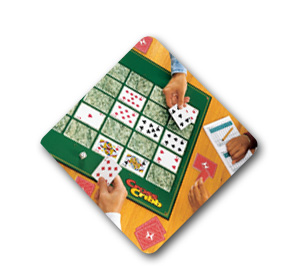
|
|
          |
| |
 |
The following excerpt was
written by Peter Sarrit for The Game Report in 1997.
There’s only one person with whom I play cribbage. Which isn’t
to say I haven’t played the game much. Far from it. In college,
Dave and I could often be found in the lounge or dining hall pegging
a few points. At 15 cents a point I’ve earned quite a bit of extra
cash. There was no doubt the board would be dusted off during Dave’s
recent two-week visit. CrossCribb arrived on my doorstep on the last
day of that visit, and for the rest of the afternoon it became our
new obsession.
Crosscribb puts a twist on Cribbage which seems so obvious, it’s
hard to believe nobody’s thought of it before. I’ve seen
solitaire versions of this approach, but never a version for more
than one player.
|
|
|
| |
Rules are
provided for up to six players, but I’ll focus on the two player
game since that’s what we played. Each player is dealt a stack
of fourteen cards which he must not examine. This alone proved to be
difficult as picking up our hands had become a reflex!
“ Don’t look at your cards” became our mantra.
As in cribbage, a card is cut to add to the crib. This card is placed in the
center of a 5x5 grid. Starting with the dealer’s opponent, each player
looks at his top card and either tosses it into the crib (if he hasn’t
already done so twice this hand), or plays it on any vacant space in the grid.
One player is trying to build the best possible hands in each column, while the
other tries to do the same with the rows.
When all cards have been played, each five card hand is scored and the dealer
adds the crib to his total. The player with the higher total scores the difference
between the totals, with the game going to the first player to reach 31.
Cribbage had become a mechanical affair for us, both in choosing which cards
to toss into the crib and which cards to play when. We went through the motions,
with a rare play sparking some actual thought. CrossCribb put a whole new spin
on things. With pegging removed, you concentrate on building the best hands and
stopping your opponent from doing the same.
The balance between offensive and defensive card play is devilish. If my opponent
has already created a row with 4-5-5-6, playing an 8 into it is a no-brainer.
But what if I draw a queen? Do I give him 4 points, or do I risk him drawing
a 4, 5 or 6? Tough call– especially since I could place the queen in one
of the columns with a 5, scoring points for myself. And if the queen’s
the same suit as one of the fives, it becomes an even tougher choice.
You only need four cards of the same suit for a flush, which adds a frustrating
component to defensive play. You want to break up the forming double run, but
the card you just drew would give a flush instead. Play it anyway, or hope your
opponent doesn’t draw what he needs and you get a better stopper next time?
The board provides a convenient 5x5 grid to play onto, the scorepads are nicely
designed to eliminate the need for a cribbage board, and a deck of cards is included.
I’ll say this: the components are all of good quality– this isn’t
a back-room DTP production.
By the time Dave left we’d both become CrossCribb converts, and I’d
become a bit richer, as usual. |
|
|
|
|
|
| |
|
|
|
|
|
|
|
| |
|
|
|
|
|
|
|
| |
 |
|
| |
CrossCribb®
is a registered trademark of Maynard's.
Copyright © 1996, 2001, 2008 Maynard's, Minneapolis, MN 55422. All
rights reserved.
|
|
|